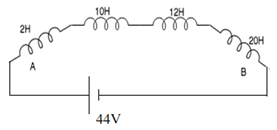This set of Basic Electrical Engineering Multiple Choice Questions & Answers (MCQs) focuses on “Coils Connected in Series”.
1. What is the equivalent inductance when inductors are connected in series?
a) Sum of all the individual inductances
b) Product of all the individual inductances
c) Sum of the reciprocal of all the individual inductances
d) Product of the reciprocal of all the individual inductances
View Answer
Explanation: When inductances are connected in series, the equivalent inductance is equal to the sum of all the individual inductance values.
2. When inductances are connected in series, the equivalent inductance is ____________ the largest individual inductance.
a) Greater than
b) Less than
c) Equal to
d) Not related to
View Answer
Explanation: When inductances are connected in series, the equivalent inductance is equal to the sum of all the individual inductance values. Hence the equivalent inductance is greater than the largest individual inductance.
3. Three inductors having inductance values 3H, 4H and 5H are connected in series, calculate the equivalent inductance.
a) 10H
b) 12H
c) 3H
d) 5H
View Answer
Explanation: When inductances are connected in series, the equivalent inductance is equal to the sum of all the individual inductance values.
Hence Leq= L1+L2+L3= 12H.
4. Calculate the equivalent inductance between A and B.

a) 30H
b) 54H
c) 44H
d) 60H
View Answer
Explanation: The 4 inductors are connected in series, hence their equivalent inductance is:
Leq=L1+L2+L3+L4=44H.
5. When inductors are connected in series, the voltage across each inductor is _________
a) Equal
b) Different
c) Zero
d) Infinity
View Answer
Explanation: In a series circuit, the current across all elements remain the same and the total voltage of the circuit is the sum of the voltages across all the elements. The voltage across each inductor in series is different.
6. In a series circuit, which of the parameters remain constant across all circuit elements such as resistor, capacitor, inductor etc?
a) Voltage
b) Current
c) Both voltage and current
d) Neither voltage nor current
View Answer
Explanation: In a series circuit, the current across all elements remain the same and the total voltage of the circuit is the sum of the voltages across all the elements.
7. Find voltage across 2H inductor.

a) 2V
b) 10V
c) 12V
d) 20V
View Answer
Explanation: e=Ldi/dt
Leq=2+10+12+20=44H
di/dt=44/44 = 1 A/s.
Voltage across 2H inductor = 2*di/dt = 2*1=2V.
8. Find voltage across 10H inductor.

a) 2V
b) 10V
c) 12V
d) 20V
View Answer
Explanation: e=Ldi/dt
Leq=2+10+12+20=44H
di/dt=44/44 = 1 A/s.
Voltage across 10H inductor = 10*di/dt = 10*1=10V.
9. Find voltage across 12H inductor.

a) 2V
b) 10V
c) 12V
d) 20V
View Answer
Explanation: e=Ldi/dt
Leq=2+10+12+20=44H
di/dt=44/44 = 1 A/s.
Voltage across 12H inductor = 12*di/dt = 12*1=12V.
10. Find voltage across 20H inductor.

a) 2V
b) 10V
c) 12V
d) 20V
View Answer
Explanation: e=Ldi/dt
Leq=2+10+12+20=44H
di/dt=44/44 = 1 A/s.
Voltage across 20H inductor = 20*di/dt = 20*1=20V.
Sanfoundry Global Education & Learning Series – Basic Electrical Engineering.
To practice all areas of Basic Electrical Engineering, here is complete set of 1000+ Multiple Choice Questions and Answers.
If you find a mistake in question / option / answer, kindly take a screenshot and email to [email protected]
